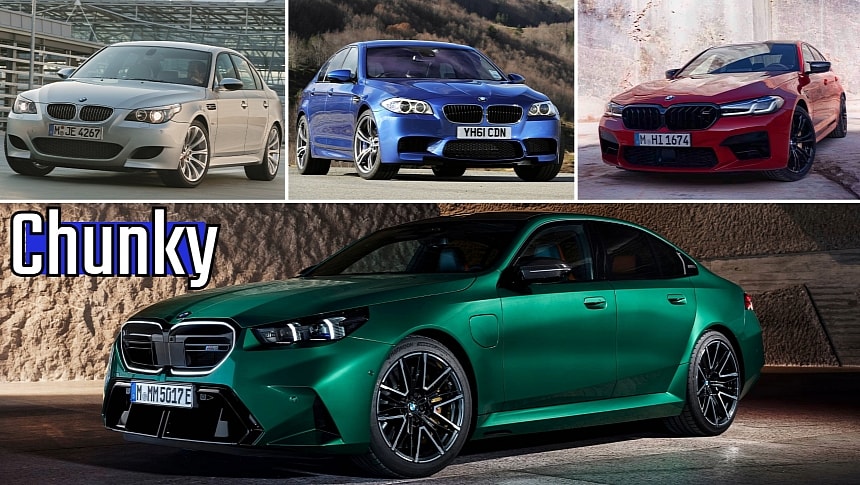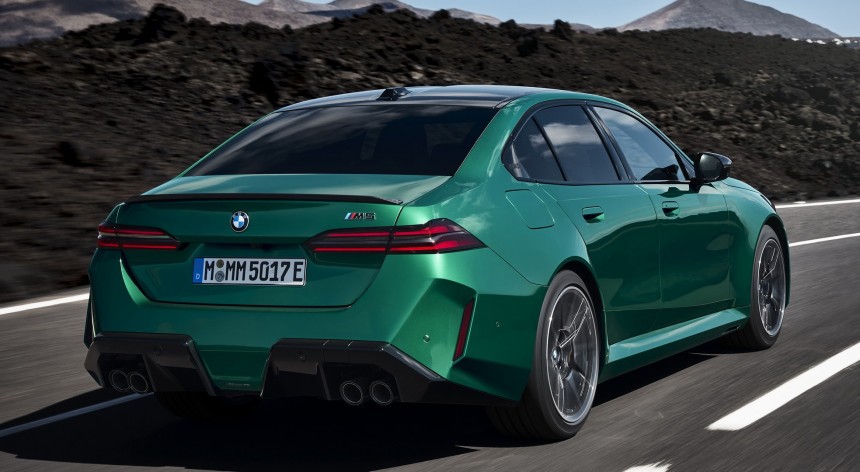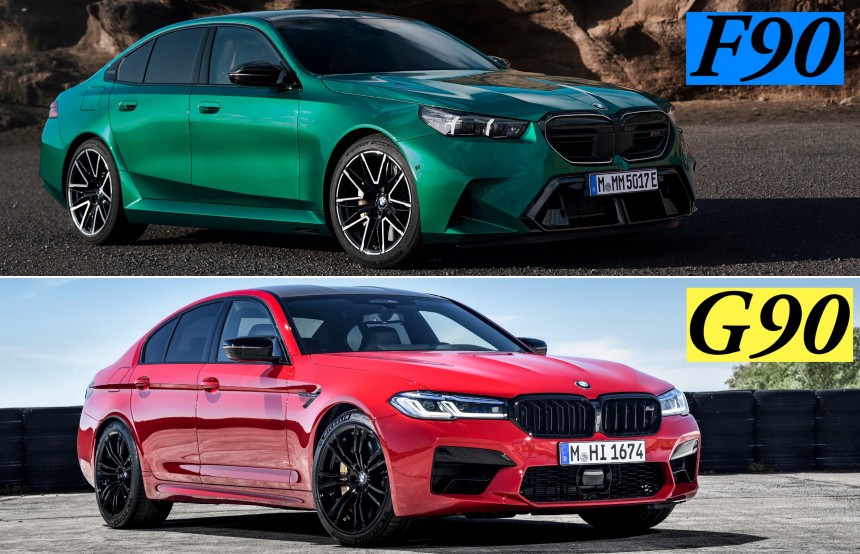Electrification, together with stringent emissions regulations, forced BMW to make the all-new G90 M5 roughly 1,000 lbs heavier than its predecessor. The new M5 is bigger than ever, and it now comes with an electric motor and a battery pack. The ultimate driving machine is officially fat.
Now that we’ve had a few good days to get used to the idea of a new and shockingly heavy M5, we should probably try and figure out how we got here. Most of all, how BMW ended up going this route with a nameplate that stood at the very heart of its range.
You can’t say ‘Ultimate Driving Machine’ without thinking about either the M3 or the M5. They are the quintessential BMW sedans, and their dynamic characteristics should be ‘protected’ like the holy grail. In other words, engineers shouldn’t be making decisions that end up having a negative effect on such cars, and if you look at the numbers, it’s pretty much all negative.
The new G90 M5 weighs a monster 5,390 lbs (2,445 kg), making it roughly 1,000 lbs heavier than its predecessor, the F90 M5 – itself weighing about the same as the F10 M5, which was a major achievement for BMW.
There’s no way to sugarcoat this. The new M5 weighs as much as a Chevrolet Tahoe, and it’s supposed to be a performance sedan. The ultimate performance sedan, that is.
The first question I asked myself when the specs for the G90 were first revealed was: “Why this particular powertrain?” It’s a 4.4-liter twin turbocharged V8 with a plug-in hybrid setup, meaning an electric motor and a battery pack. There’s some added weight right there. Of course, since the G90 M5 is based on the G60 5 Series, a size/weight problem was always going to be there. The 5er is now bigger than ever before.
If you recall, I drove the new 5 Series, both with an internal combustion engine, as well as the fully electric i5 M60 variant, and while they were both solid in most respects, neither felt as light on their feet as previous iterations. The difference might be negligible to most drivers, but enthusiasts (especially BMW M5 buyers) will surely notice the heft. There are many ways to hide extra weight, but one place you can’t hide is under braking.
Then there’s the MSRP, which kicks off from $119,500. Not bad at all given what the market is like today. When you factor in inflation, the fact that this is only a few thousand dollars more expensive than a 2023 M5 is quite impressive.
Until then, we must accept that BMW, like most other carmakers, must adhere to emissions regulations. What, you think making the new M5 a plug-in hybrid was their first choice? Not in their wildest dreams. Back when they unveiled the F90 M5 and thoughts began to wonder towards a successor, why would they even picture something heavier by 1,000 lbs and with a worse horsepower per ton rating?
Oh, you didn’t know what? The new M5 has a power to weight ratio of 295 hp per ton, the exact same as the F10 M5 from two generations ago. Meanwhile, the F90 M5, which came out in 2017, is rocking 320 hp per ton.
When the M5 does go ‘full EV’, it’ll probably still suffer from a few G90 ailments, such as size and heft, but given time, battery technology will keep progressing and I truly believe that carmakers will figure out ways to make their vehicles more lightweight again.
You can’t say ‘Ultimate Driving Machine’ without thinking about either the M3 or the M5. They are the quintessential BMW sedans, and their dynamic characteristics should be ‘protected’ like the holy grail. In other words, engineers shouldn’t be making decisions that end up having a negative effect on such cars, and if you look at the numbers, it’s pretty much all negative.
The new G90 M5 weighs a monster 5,390 lbs (2,445 kg), making it roughly 1,000 lbs heavier than its predecessor, the F90 M5 – itself weighing about the same as the F10 M5, which was a major achievement for BMW.
There’s no way to sugarcoat this. The new M5 weighs as much as a Chevrolet Tahoe, and it’s supposed to be a performance sedan. The ultimate performance sedan, that is.
The first question I asked myself when the specs for the G90 were first revealed was: “Why this particular powertrain?” It’s a 4.4-liter twin turbocharged V8 with a plug-in hybrid setup, meaning an electric motor and a battery pack. There’s some added weight right there. Of course, since the G90 M5 is based on the G60 5 Series, a size/weight problem was always going to be there. The 5er is now bigger than ever before.
So, is it all bad?
Well, no, of course not. The new M5 is still an extremely handsome vehicle, and thanks to its 717 horsepower (727 ps) and 738 lb-ft (1,000 Nm) of torque, it’ll get you to 60 mph in 3.4 seconds. It’s slower than the F90 M5 (at its best), but only by 0.2 seconds. I doubt you’ll notice the difference in a straight line, at least not during everyday driving.Then there’s the MSRP, which kicks off from $119,500. Not bad at all given what the market is like today. When you factor in inflation, the fact that this is only a few thousand dollars more expensive than a 2023 M5 is quite impressive.
What about that whole “necessary evil” thing?
Once BMW committed to going this route with the new 5 Series, they pretty much sealed the fate of the M5 too. The G60 5er was always going to be a split personality car, with a focus on electrification. Any internal combustion variant was going to take a backseat to the i5 in terms of engineering and due diligence. In other words, BMW had to take us here for us to get to where we really want to go – and where we want to go is a future in which battery packs are lightweight, and electric motors are even more carefully packaged.Until then, we must accept that BMW, like most other carmakers, must adhere to emissions regulations. What, you think making the new M5 a plug-in hybrid was their first choice? Not in their wildest dreams. Back when they unveiled the F90 M5 and thoughts began to wonder towards a successor, why would they even picture something heavier by 1,000 lbs and with a worse horsepower per ton rating?
What does the future of BMW M look like?
It’s probably not as bleak as some of us might think right now. Granted, current times are tough, especially if you’re a so-called “petrol head”, and long term, you’ll have no choice but to accept electrification in its entirety. The M5 nameplate will, at one point, become fully electric, we just don’t know if it’ll happen before the end of the decade, or sometime after that.When the M5 does go ‘full EV’, it’ll probably still suffer from a few G90 ailments, such as size and heft, but given time, battery technology will keep progressing and I truly believe that carmakers will figure out ways to make their vehicles more lightweight again.


















